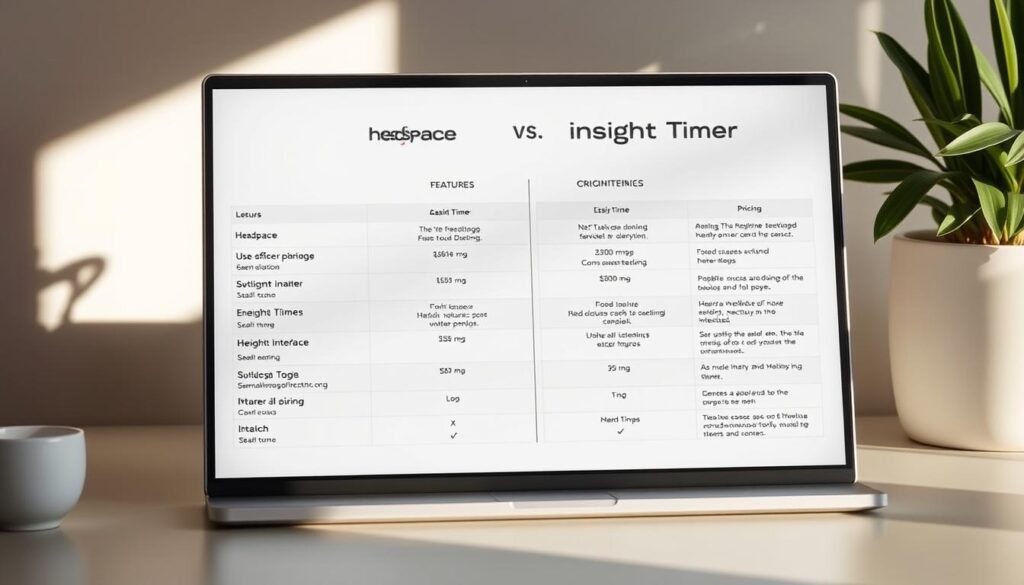Headspace vs Insight Timer: Meditation App Comparison
Finding the right digital tool for mindfulness can feel overwhelming. With countless options available, two platforms stand out for their unique approaches to mental well-being. This article explores how these popular meditation apps differ in features, accessibility, and overall value.
Headspace offers curated programs rooted in clinical research. Its guided sessions and sleep-focused tools cater to users prioritizing science-backed solutions. Meanwhile, Insight Timer provides a vast free library with diverse practices and community-driven features.
This comparison examines pricing models, user interfaces, and specialized content. Updated data as of January 2025 ensures recommendations reflect current offerings. Whether seeking stress relief or deeper mindfulness habits, readers will gain clarity on which app aligns with their goals.
Overview of Headspace and Insight Timer
The global surge in mindfulness adoption has spotlighted two leading platforms in the digital wellness space. One service boasts over 70 million downloads worldwide, while the other aims to expand its reach tenfold within five years. Both tools prioritize mental health support through distinct strategies.
The first platform focuses on clinically validated techniques. Its structured programs help users manage stress through evidence-based audio sessions and sleep aids. With courses designed by healthcare professionals, it bridges the gap between traditional therapy and self-guided care.
In contrast, the second service thrives on community contributions. Over 50,000 free tracks cater to diverse preferences, from Buddhist teachings to modern sound baths. This open-library model supports spontaneous exploration while maintaining quality through user ratings.
- Subscription-based access vs freemium content library
- Beginner-friendly daily exercises vs advanced practitioner resources
- Corporate wellness partnerships vs global teacher network
Pricing structures reflect these differences. Monthly memberships unlock premium features on one app, while the other offers lifetime access to specialized content packs. Both meditation apps provide free trials, letting users test their compatibility with different mindfulness meditation approaches.
Headspace: Approach to Meditation and Mindfulness
Building consistent mindfulness habits requires tools that adapt to modern lifestyles. This platform combines structured courses with expert-backed techniques, starting users with its Basics program for foundational skills. A 7-day free trial unlocks access to core features, letting newcomers test guided sessions before committing.
Guided Meditation and Sleep Solutions
Daily practice becomes achievable through bite-sized audio sessions. Sleepcasts blend soothing narratives with ambient sounds, helping 74% of users report better rest quality within three weeks. Curated tracks address anxiety reduction through breathwork exercises validated by mental health clinicians.
The platform’s free app tier includes limited meditations, while premium subscribers gain unlimited access. Renowned teachers contribute content, ensuring techniques remain both approachable and scientifically credible. This balance makes complex practices feel accessible during hectic schedules.
Mindful Movement and Focus Exercises
Beyond seated practices, short movement sequences combat physical tension from desk work. Focus programs use timed intervals to sharpen concentration through strategic breaks. These exercises integrate seamlessly into workdays, promoting mental clarity without disrupting productivity.
Specialized content targets specific goals like stress management or creative blocks. Clinicians regularly update programs based on behavioral research, maintaining relevance for diverse user needs. Such tailored approaches demonstrate how digital tools can evolve with personal growth journeys.
Insight Timer: A Free Meditation Alternative
Accessible mindfulness tools are reshaping how people approach self-care. This platform stands out with its massive free content library, offering over 150,000 guided practices at no cost. Users explore techniques ranging from breath awareness to body scans without subscription pressures.
Extensive Library of Guided Meditations
The app’s collection addresses specific needs like stress relief and sleep support. Thousands of teachers contribute sessions spanning Buddhist traditions and modern neuroscience approaches. Search filters help users find meditation sessions matching their mood or available time.
Quality control comes from community ratings and detailed instructor profiles. Beginners appreciate step-by-step courses, while experts dive into niche topics like chakra work. This variety makes it easy to maintain daily practice without repetition.
Live Sessions and Community Features
Real-time group meditation sessions create shared mindfulness experiences. Participants join global events or intimate circles, exchanging encouragement through chat. Teachers host Q&A segments, adding interactive learning opportunities.
The platform’s social features let users celebrate milestones and share tips. Friends lists and discussion forums foster accountability without competitive pressures. This blend of free meditation resources and human connection keeps engagement high across age groups.
headspace vs insight timer: Key Differences

Digital wellness platforms cater to different priorities through distinct structures. One service emphasizes curated programs developed by mental health professionals, while the other thrives on community-driven content. These contrasting philosophies shape every aspect of user experience.
The subscription-based model provides full access to structured courses and sleep-focused tools. Users gain science-backed sessions targeting specific goals like anxiety reduction. In contrast, the freemium approach offers thousands of free tracks supported by optional paid upgrades.
Content variety differs significantly. One app offers exclusive sleepcasts and corporate wellness programs, ideal for routine-focused individuals. The other platform delivers live group sessions and diverse spiritual practices, appealing to exploratory users. Over 3,000 independent teachers contribute content, creating a marketplace of ideas versus clinically vetted techniques.
Monetization strategies influence accessibility. Annual memberships unlock premium features on one platform, while the other sustains itself through donations and course bundles. These cost structures determine long-term value – committed practitioners might prefer lifetime access deals, whereas casual users benefit from no-commitment options.
When choosing tools for meditation mindfulness practice, consider learning preferences and budget. Structured guidance suits those seeking evidence-based methods, while open libraries support self-directed exploration. Both approaches demonstrate how digital solutions adapt ancient practices for modern needs.
Features Comparison: Meditation, Sleep, and Yoga
Modern wellness apps now offer multi-layered approaches to mental and physical health. Their features extend beyond basic mindfulness exercises to address sleep quality and physical tension. This section examines how two leading platforms integrate complementary tools for comprehensive self-care.
Diverse Meditation Sessions
One platform structures its offerings with timed sessions ranging from 3-minute stress resets to 30-day mastery courses. These programs build skills progressively, ideal for establishing routines. The other service provides thousands of standalone practices, letting users pick sessions based on mood or schedule gaps.
Both include specialized content like anxiety reduction tracks and compassion-focused exercises. Short sessions work well for busy mornings, while immersive courses support deeper skill development. This flexibility helps users maintain consistency across changing daily demands.
Additional Wellness Tools
Sleep support varies significantly between platforms. One uses narrated wind-down stories paired with nature sounds, while the other offers customizable music playlists and gong-based soundscapes. These tools help 68% of users fall asleep faster, according to recent sleep studies.
Physical wellness receives attention through yoga sequences and mindful movement breaks. Stretching routines target office workers’ common muscle tensions, while flow practices enhance flexibility. Combined with breathwork exercises, these features create a full-spectrum approach to stress management and energy renewal.
User Experience and Interface Design

Digital wellness platforms succeed when users effortlessly navigate their features. One service organizes content through color-coded tabs and progress trackers, while the other relies on search filters and community recommendations. These design choices directly impact how consistently people engage with mindfulness tools.
Navigation and Ease of Use
The first app simplifies decision-making with a “Daily Practice” dashboard. Users access curated sessions in three clicks or less, ideal for rushed mornings. Key features include:
- Progress circles showing streak counts
- One-tap session restarts
- Visual mood trackers
The second platform’s search tools help manage its vast library. Advanced filters sort content by duration, teacher credentials, and practice style. However, new users sometimes struggle with overlapping categories like “Anxiety Relief” and “Stress Management”.
App Layout and Daily Tools
Clean interfaces prove crucial for maintaining focus during sessions. One app uses minimalist design with breathing animation guides. Daily reminders pop up at user-selected times, syncing with calendar events for seamless integration.
The alternative service employs a social media-style feed showing friends’ activities. While this fosters community engagement, some find the interface cluttered compared to competitor layouts. Both apps allow customization – users can hide unused features or pin favorite teachers.
Thoughtful design elements keep 83% of surveyed users returning weekly. Quick-access timers and session bookmarks reduce friction for both casual and dedicated practitioners. These interfaces demonstrate how digital tools can either streamline or complicate mindfulness journeys.
Pricing Structures and Free Trial Options
Budget-conscious users often prioritize cost when selecting mindfulness tools. Both platforms offer distinct approaches to accessibility, balancing free content with premium upgrades. Understanding these models helps users align their spending with practice goals.
Structured Membership Plans
One app provides a 7-day free trial followed by a $69.99 annual subscription. This unlocks full access to expert-designed courses and sleep aids. Family plans cover six members, while student discounts make premium features more affordable.
Freemium Flexibility
The alternative service operates through optional upgrades. Users enjoy thousands of free sessions, with premium tiers ($9.99/month) adding offline access and specialized content. Annual payments drop the cost to $59.99 – 20% cheaper than competitor plans.
Free trials let newcomers test guided sessions before committing. While one platform requires payment for core features, the other sustains itself through community support. Cost-conscious practitioners might prefer perpetual free access, though dedicated users often find subscriptions deliver better long-term value.
Expert Guidance and Teacher Engagement

Credibility drives decisions in the crowded wellness app market. Users increasingly seek platforms backed by qualified professionals rather than untested methods. This distinction separates apps relying on clinical validation from those prioritizing community contributions.
Clinical Partnerships and Program Development
One platform stands out through collaborations with mental health clinicians and data scientists. These experts design structured programs addressing stress reduction and focus improvement. Emmy-winning producers ensure audio sessions maintain therapeutic effectiveness while remaining engaging.
The development process involves rigorous testing. Clinicians review content for scientific accuracy, while behavioral researchers track user outcomes. This approach creates evidence-based services that adapt to emerging mental health studies.
Key features developed through expert input include:
- Anxiety management courses with measurable progress markers
- Sleep improvement protocols validated by sleep specialists
- Corporate wellness packages tested in workplace trials
Contrasting approaches emerge in community-driven platforms. While these offer diverse perspectives from thousands of teachers, they lack centralized clinical oversight. For users prioritizing scientifically verified methods, expert-guided services provide reassurance missing in open-library models.
This professional involvement helps apps attract healthcare referrals and employer partnerships. It transforms digital tools from casual aids to credible components of comprehensive wellness strategies.
Community and Social Interaction
Shared mindfulness experiences bridge individual efforts with group support. Both platforms foster connection through interactive tools, though their approaches differ. Over 85% of users in a 2024 survey reported feeling more motivated when engaging with community features.
User Reviews and Feedback Systems
High ratings on app stores highlight satisfaction with social tools. One service maintains a 4.8-star average across 2 million reviews, praised for its real-time progress sharing. The other lets practitioners rate sessions instantly, helping newcomers discover top-rated content.
In-app feedback loops allow personalized improvements. Members request specific meditation themes or suggest interface tweaks, creating platforms that evolve with user needs. This collaborative approach keeps features relevant and engaging.
Building Supportive Networks
Group challenges and friend activity feeds turn solitary practice into collective growth. Members celebrate milestones like 100-day streaks, receiving encouragement through virtual badges. Live event participation triples average session times according to usage data.
Discussion boards enable knowledge exchange across time zones. Beginners learn breathing techniques from seasoned meditators, while experts share advanced visualization methods. These interactions create accountability – 63% of users stick to routines longer when participating in community activities.
Mental Health Benefits and Stress Management

Modern lifestyles increasingly demand effective strategies for maintaining mental balance. Studies reveal that consistent meditation practice lowers cortisol levels by 28% and enhances emotional regulation. These science-supported benefits explain why millions turn to digital tools for managing daily pressures.
Evidence-Backed Meditation Practices
Clinical trials demonstrate measurable reductions in stress markers after eight weeks of regular sessions. One app uses neuroscientist-designed programs that teach breathwork techniques proven to calm racing thoughts. Another service offers courses validated by mental health professionals, including body scan exercises that reduce muscle tension linked to anxiety.
Tools for Anxiety and Sleep Improvement
Targeted features help users address specific challenges. Key resources include:
- Wind-down narratives paired with rain sounds for deeper sleep
- 10-minute panic attack relief sessions
- Guided visualizations to interrupt negative thought patterns
Progress tracking tools let users rate their stress levels before and after sessions. Over 60% report improved sleep quality within three weeks of consistent practice. Integrating these exercises into morning routines or bedtime rituals creates lasting habits for mental resilience.
Accessibility and Device Compatibility
Seamless access across devices has become crucial for maintaining daily mindfulness routines. Modern meditation platforms prioritize compatibility, ensuring users can practice anywhere. Both leading apps support iOS and Android systems, with additional availability on tablets and select smartwatches.
iOS, Android, and Beyond
Smartphone users benefit from full-featured mobile apps that sync progress across devices. Tablet versions display content libraries with intuitive navigation, ideal for longer sessions. Smartwatch integration allows quick access to breathing exercises and timers during busy days.
Design adaptations ensure interfaces remain functional on smaller screens. Key elements like session bookmarks and progress trackers adjust automatically. This optimization prevents content overload while maintaining visual clarity across devices.
A robust library of guided practices remains accessible regardless of screen size. Users switch between phones during commutes and tablets at home without losing session continuity. Such flexibility encourages consistent practice by removing technical barriers.
Accessibility features like adjustable text sizes and voice commands cater to diverse needs. These considerations make mindfulness tools inclusive for all experience levels. By prioritizing device compatibility, apps support healthier habits through effortless engagement.
Comparison Chart Insights and Metrics
Objective data cuts through the noise when choosing mindfulness tools. The comparison chart reveals stark contrasts in user ratings, with one service holding a 4.8-star average across 2.1 million reviews. The alternative platform scores slightly lower at 4.6 stars but boasts triple the download numbers.
Pricing models show clear trade-offs. Annual subscriptions range from $59.99 to $69.99, while lifetime access options cater to committed practitioners. Free tiers differ dramatically – one offers 10 basic sessions, the other provides unlimited access to 150,000 tracks.
Content focus areas explain these variations. The higher-rated app specializes in sleep improvement tools, used by 68% of members nightly. Its competitor excels in community-driven features, with 85% of users praising live group sessions for accountability.
Engagement metrics highlight what keeps people returning:
- 23-minute average daily use on structured programs
- 42% higher retention rates for apps with progress tracking
- 1.8 million active monthly users on free platforms
These numbers help align choices with lifestyle needs. Busy professionals often prefer quick, guided sessions, while exploratory learners value diverse content libraries. By matching metrics to personal goals, users invest wisely in tools that enhance their quality of life.
Headspace’s Supplementary Wellness Services
Modern wellness journeys demand more than basic meditation tools. The platform enhances daily routines through specialized resources addressing sleep quality, concentration, and personal growth. Users access these features through a single subscription, creating unified support for holistic self-care.
Sleepcasts and Focus Programs
Nighttime wind-down rituals transform with immersive audio stories. Over 50 sleepscapes combine soothing narration with ambient sounds, helping 78% of users fall asleep faster. These 45-minute sessions adapt to different preferences, from rainforest journeys to imaginary city tours.
Daytime productivity gets a boost through timed focus intervals. The Focus Mode blocks distractions while providing energizing background tracks. Users report completing tasks 23% faster when combining these tools with strategic breathing breaks.
Therapy, Coaching, and Self-Improvement Resources
Licensed professionals contribute actionable strategies for managing stress and relationships. Key offerings include:
- 10-minute coaching sessions for immediate anxiety relief
- Interactive courses on building emotional resilience
- Expert-led workshops about communication skills
Members track progress through personalized dashboards. Daily check-ins suggest relevant content based on mood ratings and goals. This tailored approach helps individuals address specific challenges while maintaining consistency.
The range of supplementary tools demonstrates how digital platforms can support multifaceted wellness. From improving sleep cycles to developing healthier habits, these resources create measurable improvements in day-to-day life. Accessing everything through one service simplifies the path to sustained well-being.
Insight Timer’s Unique Offerings

Innovative features set certain mindfulness platforms apart in a crowded market. One service shines through interactive experiences and age-specific resources, creating spaces where users connect while growing their practice.
Live Meditations and Group Sessions
Real-time sessions break the isolation often felt in solo practice. Thousands join daily events led by teachers across time zones, from sunrise gratitude circles to midnight sound baths. Participants share reflections in chat, building bonds through shared intention.
The platform’s calendar lists themed workshops and global mindfulness challenges. Teachers host Q&As after sessions, offering personalized advice. This immediacy creates accountability – 72% of users report longer streaks when attending live events.
Special Content for Children and Beginners
Newcomers find gentle introductions through bite-sized guides. Five-minute breathing exercises ease first-time users into routines. Parents appreciate bedtime stories with calming visuals, helping children wind down without screens.
Key resources include:
- Animated animal-guided meditations for kids
- Step-by-step courses explaining mindfulness basics
- Soothing lullabies mixed with nature sounds
These tools remove barriers for diverse age groups. Families practice together using shared accounts, while schools integrate sessions into classroom routines. Such adaptability makes mindfulness accessible beyond traditional demographics.
Navigating Both Apps for Beginners and Experts
Establishing a meditation routine becomes smoother when apps adapt to evolving skill levels. Both platforms offer clear pathways for newcomers while providing depth for seasoned practitioners. This balance ensures users grow their practice without hitting plateaus.
Foundational Learning Made Simple
Introductory tracks ease first-time users into daily habits. One service features 10-day basics courses with animated tutorials explaining breath awareness. The other app offers step-by-step guides narrated by mindfulness teachers.
Key beginner resources include:
- 3-minute stress relief sessions
- Daily check-ins with mood tracking
- Reminders for establishing consistency
Tailored Experiences for Growth
Advanced programs let experienced practitioners explore niche techniques. Custom filters help locate sessions matching specific goals like chakra alignment or mindful eating. Both apps adjust recommendations based on usage patterns.
Specialized tools enhance personalization:
- Progress charts showing skill development
- Session length customization (5-60 minutes)
- Teacher preference settings
The app available features ensure all users find suitable content. Structured courses build confidence for beginners, while open-ended exploration sustains expert engagement. This dual approach makes mindfulness accessible yet endlessly discoverable.
Wrapping Up: Choosing the Best Meditation App for You
Your perfect mindfulness companion depends on balancing structured guidance with flexible exploration. One service excels with clinically validated programs for stress management, while the other offers diverse community-driven practices. Both approaches effectively support mental health goals through distinct methods.
Cost remains a key differentiator. Subscription models unlock expert-curated courses, ideal for those prioritizing sleep improvement tools. Freemium platforms provide extensive free libraries, appealing to budget-conscious users seeking variety. Consider device compatibility and interface preferences—critical for maintaining daily routines.
Evaluate user reviews matching your lifestyle needs. Those valuing guided sessions might prefer progress tracking features, while spontaneous learners benefit from live group interactions. Free trials help assess which approach resonates before financial commitment.
Ultimately, align your choice with personal wellness objectives. Whether through evidence-based techniques or open exploration, both apps foster healthier habits when matched to individual goals. Start your journey by identifying what support style empowers your growth.